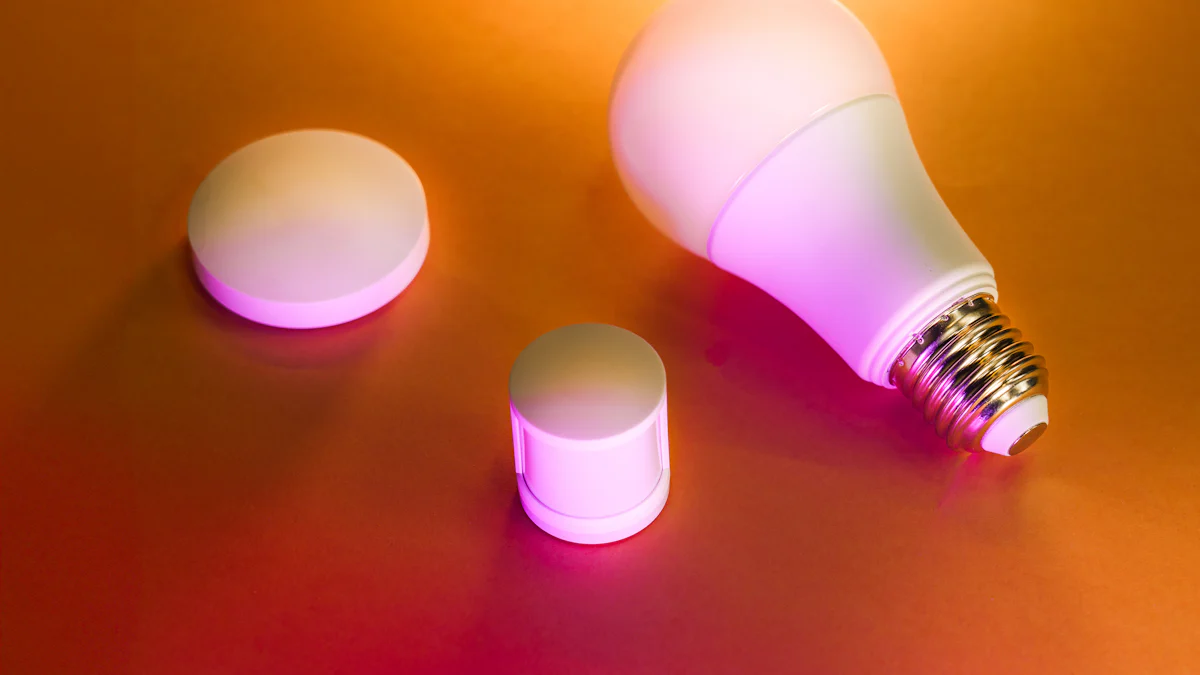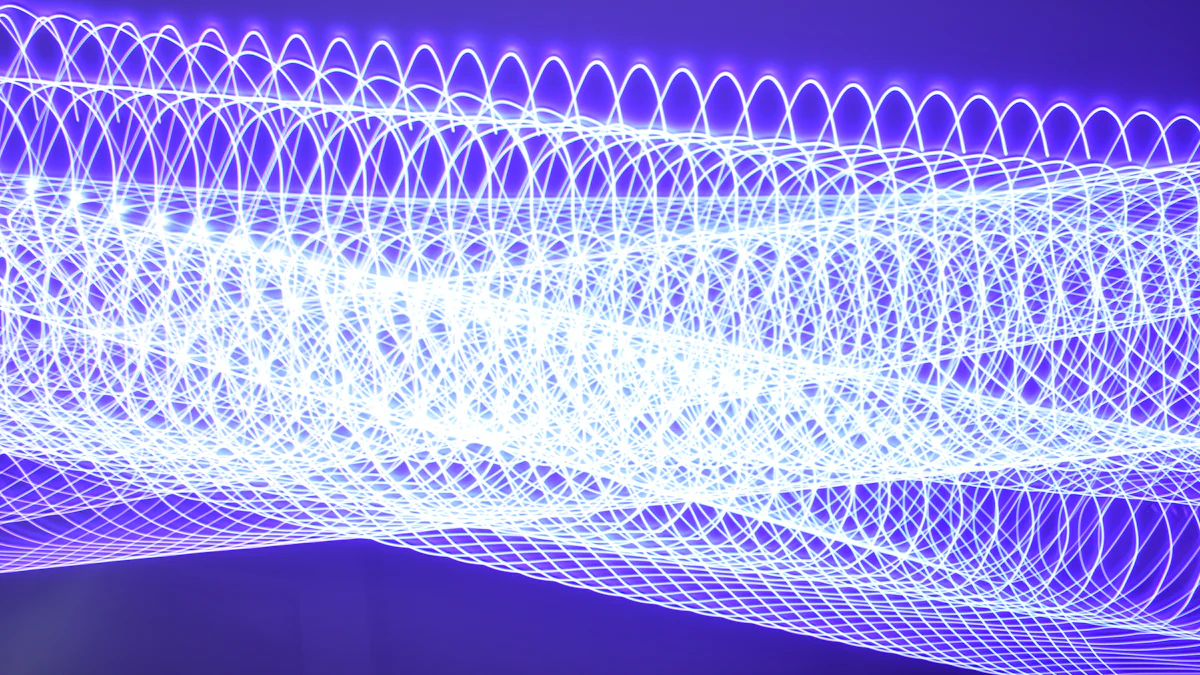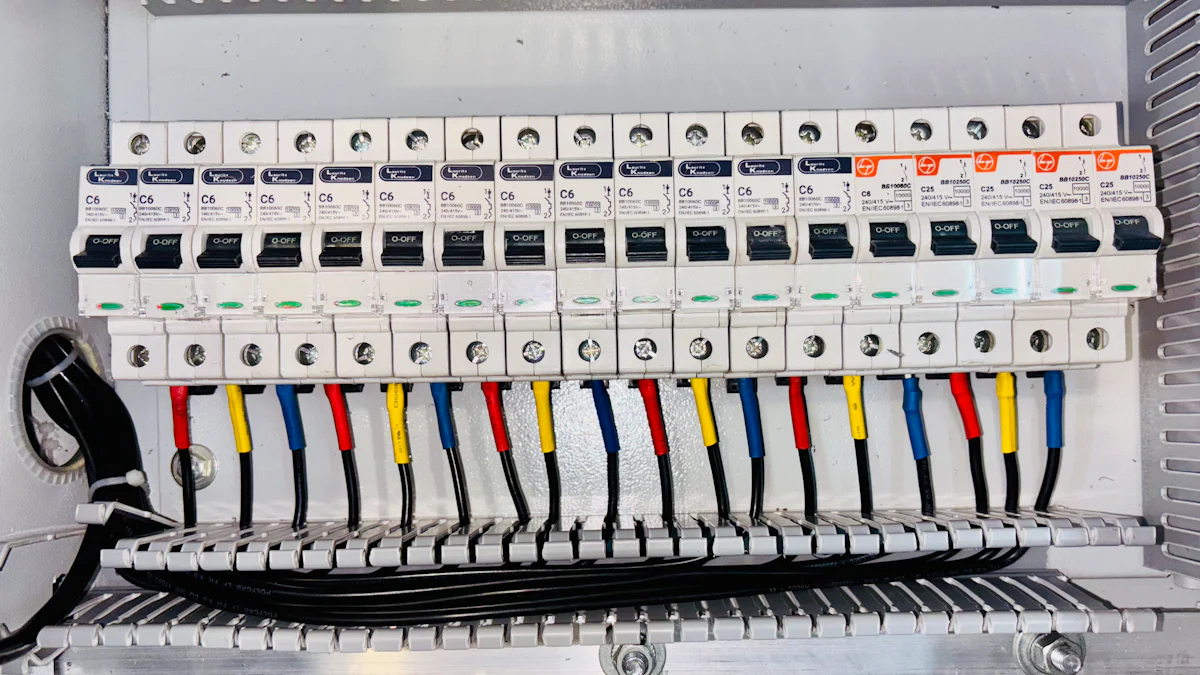Choosing Between Electronic and Magnetic Ballasts for Your Needs

Choosing the right ballast is essential for the performance and longevity of your lighting systems. A ballast regulates the current and voltage supplied to lamps, ensuring they operate efficiently and safely. However, selecting the right one can be challenging. You must consider compatibility with your lamps, energy efficiency, and environmental factors like temperature and humidity. Proper installation also plays a critical role in avoiding wiring issues.
When deciding between magnetic vs electronic ballasts, you need to evaluate your specific lighting needs. The question of "ballast electronic vs magnetic" depends on factors like energy savings, noise levels, and compatibility with modern lighting systems. Understanding these differences will help you make an informed choice.
Key Takeaways
Pick the right ballast to make your lights last longer. Check if it works with your lamps and saves energy.
Electronic ballasts save more energy and are very quiet. They are great for modern lights and places where noise matters.
Magnetic ballasts are strong and cheaper for simple uses. But they make more heat and noise, which might not work everywhere.
Think about what you need, like saving energy or your budget, to decide if electronic or magnetic ballasts are better for you.
Take care of your ballast often to avoid problems. This helps it last longer and keeps your lights working safely.
What Are Ballasts and Their Purpose?
The Role of Ballasts in Lighting Systems
Ballasts play a critical role in ensuring your lighting systems function properly. They regulate the electrical current and voltage supplied to lamps. Without a ballast, the lamp could draw excessive power, leading to overheating or failure. Ballasts also provide the initial high voltage needed to ignite the lamp and then stabilize the current for consistent operation.
Here’s what ballasts do:
Regulate the current and voltage supplied to lamps.
Provide the high voltage necessary to start the lamp.
Maintain stable operation by controlling the electrical current.
By performing these functions, ballasts protect your lighting systems and improve their efficiency. Whether you’re using fluorescent, HID, or LED lamps, the right ballast ensures safe and reliable performance.
Overview of Magnetic vs Electronic Ballasts
Magnetic ballasts have been around for decades and were the standard choice for many lighting systems. They use electromagnetic coils to control the current. While they are reliable, they tend to lose energy as heat, making them less efficient.
In the early to mid-1990s, electronic ballasts emerged as a more efficient alternative. These ballasts use a high-frequency inverter to manage power more effectively. This innovation significantly reduced energy loss and improved performance. Today, electronic ballasts are widely used in modern lighting systems due to their superior energy efficiency and compatibility with advanced technologies.
When comparing magnetic ballasts to electronic ballasts, you’ll notice key differences in performance, efficiency, and design. Magnetic ballasts are simpler and more durable but generate more heat and noise. Electronic ballasts, on the other hand, operate quietly, produce less heat, and support energy-efficient lighting systems. Understanding these distinctions will help you choose the right ballast for your needs.
Magnetic Ballasts

How Magnetic Ballasts Work
Magnetic ballasts regulate the flow of electricity in lighting systems, ensuring lamps operate safely and efficiently. These devices, often referred to as chokes, use an electromagnetic field created by a tightly wound coil. When current flows through the coil, the ballast restricts most of it, allowing only a controlled amount to pass. This process prevents excessive current that could damage the lamp.
In fluorescent lighting systems, magnetic ballasts act as control gear. They supply the high voltage needed to ignite the lamp and then adjust the voltage to maintain steady operation. Their design accommodates the varying voltage and operating phases required by different lamp types. While traditional, magnetic ballasts remain reliable and durable, making them a common choice in older lighting systems.
Advantages of Magnetic Ballasts
Magnetic ballasts offer several benefits that make them suitable for specific applications.
Their durability allows them to perform well in harsh environments, such as industrial settings.
The simple construction of magnetic ballasts makes them easier to maintain compared to electronic alternatives.
They are a cost-effective option for basic lighting needs, especially in systems that do not require advanced features.
If you prioritize reliability and simplicity, magnetic ballasts can be a practical choice for your lighting system.
Disadvantages of Magnetic Ballasts
Despite their advantages, magnetic ballasts have notable drawbacks that may limit their use in modern lighting systems.
Drawback | Description |
|---|---|
Energy Efficiency | Magnetic ballasts are less energy-efficient compared to electronic alternatives. |
Flicker and Hum | They produce noticeable flickering and humming noise, which can be distracting in work environments. |
These issues can affect both performance and user experience. The lower energy efficiency of magnetic ballasts leads to higher electricity costs over time. Additionally, the flicker and hum they generate may not be suitable for offices or commercial spaces where a quiet and stable environment is essential.
While magnetic ballasts remain a reliable option, their limitations make them less ideal for modern, energy-conscious applications.
Electronic Ballasts

How Electronic Ballasts Work
Electronic ballasts regulate the flow of electricity in lighting systems using advanced solid-state electronics. Unlike magnetic ballasts, they operate at much higher frequencies, often exceeding 20,000 Hz. This high-frequency operation minimizes energy loss as heat, allowing more energy to convert into light. As a result, electronic ballasts deliver significant energy savings over time.
These ballasts also eliminate the flickering associated with older technologies. By providing a stable and flicker-free power supply, they enhance the performance of fluorescent and HID lamps. Their compact and lightweight design makes them suitable for modern lighting systems, where efficiency and reliability are essential.
Advantages of Electronic Ballasts
Electronic ballasts offer several benefits that make them a preferred choice for residential, commercial, and industrial lighting systems:
They improve energy efficiency by converting more energy into light and reducing electricity costs.
Their high-frequency operation eliminates flickering, creating a more comfortable lighting experience.
They operate quietly, making them ideal for offices, retail spaces, and other environments where noise can be disruptive.
Their smaller and lighter design simplifies installation and reduces strain on fixtures.
In commercial settings, electronic ballasts ensure stable, flicker-free lighting, which enhances visibility and productivity. They also reduce the heating load on HVAC systems, contributing to additional energy savings.
Disadvantages of Electronic Ballasts
Despite their advantages, electronic ballasts have some drawbacks:
Higher Initial Cost: These ballasts cost more upfront compared to magnetic ballasts.
Compatibility Issues: Some older lamp models may not work with electronic ballasts.
While these factors may increase initial expenses, the long-term energy savings and improved performance often outweigh the disadvantages. When upgrading older systems, you should verify compatibility to avoid potential issues.
Ballast Electronic vs Magnetic: Key Differences
Performance and Efficiency
When comparing the performance of magnetic ballasts and electronic ballasts, you’ll notice significant differences in energy efficiency and lamp performance. Magnetic ballasts operate at a line frequency of 50-60 Hz, which results in more energy loss as heat. In contrast, electronic ballasts function at frequencies exceeding 20,000 Hz. This high-frequency operation minimizes heat generation and converts more energy into light, leading to better energy efficiency.
Ballast Type | Energy Efficiency | Heat Generation |
|---|---|---|
Electronic Ballast | High | Low |
Magnetic Ballast | Low | High |
Electronic ballasts also eliminate flickering, ensuring stable lamp performance. This makes them ideal for environments where consistent lighting is essential. Magnetic ballasts, however, may cause flickering, which can reduce the quality of light output. If energy savings and improved lamp performance are priorities, electronic ballasts are the better choice.
Cost and Longevity
The upfront cost of magnetic ballasts is lower, making them a budget-friendly option for basic lighting systems. However, electronic ballasts provide long-term savings due to their superior energy efficiency and extended lifespan.
Ballast Type | ||
|---|---|---|
Magnetic Ballasts | 10 to 15 years | Affordable |
Electronic Ballasts | 15 to 20 years | More expensive upfront |
While magnetic ballasts are simpler and easier to maintain, electronic ballasts require less frequent replacement. Their longer lifespan offsets the higher initial cost, especially in large-scale installations. Regular maintenance, such as cleaning and inspections, is essential for both types to prevent overheating caused by dust accumulation.
Noise and Heat Generation
Magnetic ballasts are known for their audible humming noise during operation. This can be distracting in quiet environments like offices or classrooms. Electronic ballasts, on the other hand, operate silently, making them suitable for noise-sensitive spaces.
Magnetic ballasts produce a high-pitched hum and may cause flickering lights.
Electronic ballasts eliminate flickering and operate quietly with minimal vibration.
In terms of heat generation, magnetic ballasts release more heat, which can strain cooling systems. Electronic ballasts generate less heat, reducing the load on HVAC systems and contributing to overall energy savings.
If you value quiet operation and lower heat output, electronic ballasts are the superior option in this ballast comparison.
Compatibility with Modern Lighting Systems
When choosing a ballast, you must consider how well it works with modern lighting systems. Magnetic and electronic ballasts differ significantly in this area, and understanding these differences can help you make the right decision.
Magnetic Ballasts and Modern Lighting
Magnetic ballasts are less compatible with today’s advanced lighting technologies. They work best with older fluorescent and HID lamps. However, many modern systems, such as LED lighting, do not support magnetic ballasts.
Note: If you plan to upgrade your lighting system in the future, magnetic ballasts may limit your options.
Magnetic ballasts also struggle to meet energy efficiency standards set by modern regulations. This makes them less suitable for environmentally conscious applications.
Electronic Ballasts and Modern Lighting
Electronic ballasts are designed to work seamlessly with modern lighting systems. They support a wide range of lamp types, including fluorescent, compact fluorescent (CFL), and LED. Their high-frequency operation ensures compatibility with energy-efficient and dimmable lighting technologies.
Here’s why electronic ballasts excel in modern systems:
Versatility: They adapt to various lamp types and wattages.
Energy Compliance: They meet strict energy efficiency standards.
Advanced Features: They enable dimming and smart lighting controls.
Tip: If you want a future-proof solution, electronic ballasts are the better choice.
Quick Comparison Table
Feature | Magnetic Ballasts | Electronic Ballasts |
|---|---|---|
Compatibility with LEDs | Not Compatible | Fully Compatible |
Support for Dimming | Limited | Excellent |
Energy Efficiency Standards | Fails to Meet Modern Standards | Meets or Exceeds Standards |
Electronic ballasts provide the flexibility and efficiency required for modern lighting systems. If you aim to reduce energy costs and embrace advanced technologies, they are the ideal option.
Choosing the Right Ballast for Your Needs
Factors to Consider
Type of Lighting System
Your lighting system plays a significant role in determining the right ballast. Magnetic ballasts work well in industrial and outdoor settings like factories or street lighting, where durability is essential. On the other hand, electronic ballasts are better suited for indoor environments such as offices or retail spaces. Their quiet operation and consistent light quality make them ideal for these applications. Always ensure the ballast you choose matches the type and wattage of your lighting fixtures to avoid compatibility issues.
Energy Efficiency Goals
If energy efficiency is a priority, electronic ballasts are the superior choice. They consume less energy and reduce heat generation, which lowers electricity costs. Experts recommend upgrading both lamps and ballasts simultaneously to maximize savings. This approach can cut lighting costs by 30 to 50 percent and reduce total facility energy consumption by up to 25 percent. At the end of a ballast’s life cycle, replacing it with an electronic option paired with lower-wattage lamps can further optimize efficiency.
Tip: A complete system upgrade, including lamps, ballasts, and controls, ensures the most energy-efficient and cost-effective lighting systems.
Budget Constraints
Magnetic ballasts are more affordable upfront, making them a practical option for basic lighting needs. However, electronic ballasts offer long-term savings due to their energy efficiency and extended lifespan. When balancing cost and performance, consider factors like lamp compatibility, thermal protection, and dimming capabilities. While electronic ballasts may cost more initially, their reduced operational expenses often justify the investment.
Applications for Magnetic Ballasts
Magnetic ballasts excel in specific applications where durability and simplicity are key. They are commonly used in:
Industrial facilities with harsh environments.
Outdoor lighting systems like streetlights.
Older fluorescent or HID lighting systems.
These ballasts are ideal for settings that prioritize reliability over advanced features. However, their limitations in energy efficiency and compatibility with modern lighting systems should be considered.
Applications for Electronic Ballasts
Electronic ballasts are versatile and support a wide range of applications. They are perfect for:
Offices and classrooms requiring quiet operation.
Retail spaces where consistent, flicker-free lighting enhances the shopping experience.
Modern lighting systems, including LED and dimmable fixtures.
Environments with high energy costs, where efficiency is crucial.
Their ability to meet energy efficiency standards and support advanced technologies makes them the preferred choice for most modern lighting needs.
Choosing between magnetic and electronic ballasts depends on your specific lighting needs. Magnetic ballasts offer simplicity and durability, making them suitable for older fixtures or industrial environments. However, electronic ballasts excel in energy efficiency, quiet operation, and compatibility with modern lighting systems.
To make the right choice, consider your application. For workplaces or classrooms, prioritize electronic ballasts for flicker-free, high-quality lighting. In contrast, magnetic ballasts work well in outdoor or industrial settings. Always match the ballast to your lamp type and wattage. For residential systems, electronic ballasts paired with the correct starting method can enhance bulb lifespan and reduce energy costs.
Tip: Evaluate your energy goals, budget, and fixture compatibility to ensure your ballast choice aligns with your long-term needs.
FAQ
What is the main difference between magnetic and electronic ballasts?
Magnetic ballasts use electromagnetic coils to regulate current, while electronic ballasts rely on solid-state electronics. Magnetic ballasts are simpler but less efficient. Electronic ballasts operate at higher frequencies, offering better energy efficiency and compatibility with modern lighting systems.
Can I replace a magnetic ballast with an electronic one?
Yes, you can replace a magnetic ballast with an electronic one. Ensure the new ballast matches your lamp type and wattage. Check compatibility before installation to avoid performance issues or damage to your lighting system.
Are electronic ballasts more energy-efficient than magnetic ones?
Yes, electronic ballasts are more energy-efficient. They convert more energy into light and generate less heat. This efficiency reduces electricity costs and makes them ideal for energy-conscious applications.
Do magnetic ballasts work with LED lights?
No, magnetic ballasts are not compatible with LED lights. LEDs require electronic drivers or ballasts designed specifically for their operation. Upgrading to an electronic ballast ensures compatibility with modern LED systems.
How do I know if my ballast needs replacement?
Signs of a failing ballast include flickering lights, humming noises, or lamps that fail to start. If you notice these issues, inspect the ballast. Replace it promptly to maintain safe and efficient lighting.
Tip: Regular maintenance can extend the lifespan of your ballast and prevent unexpected failures.
See Also
Understanding Inverter And Transformer: Key Functional Differences
Essential Differences Between CR1620 And CR2032 Batteries
Your Comprehensive Guide To Selecting Car Relays Effectively
